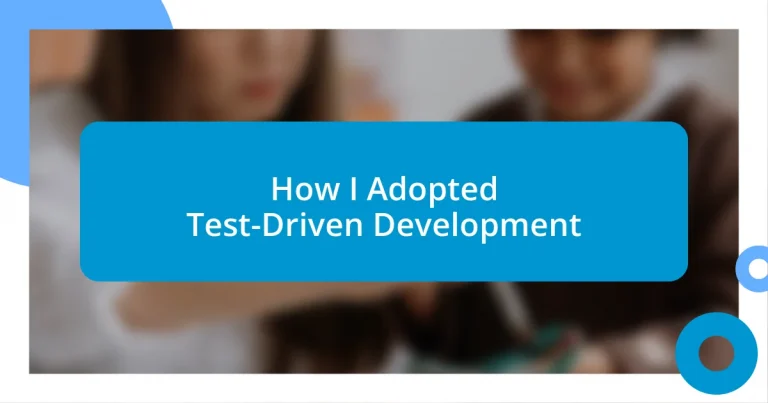Key takeaways:
- Test-Driven Development (TDD) transforms coding by requiring developers to write tests first, enhancing code reliability and fostering proactive problem-solving.
- Implementing TDD in projects improves team collaboration and communication, as shared goals through tests create a unified development approach.
- Success in TDD is measured not just by passing tests, but by not only reducing bugs post-deployment but also enhancing team discussions and overall productivity.
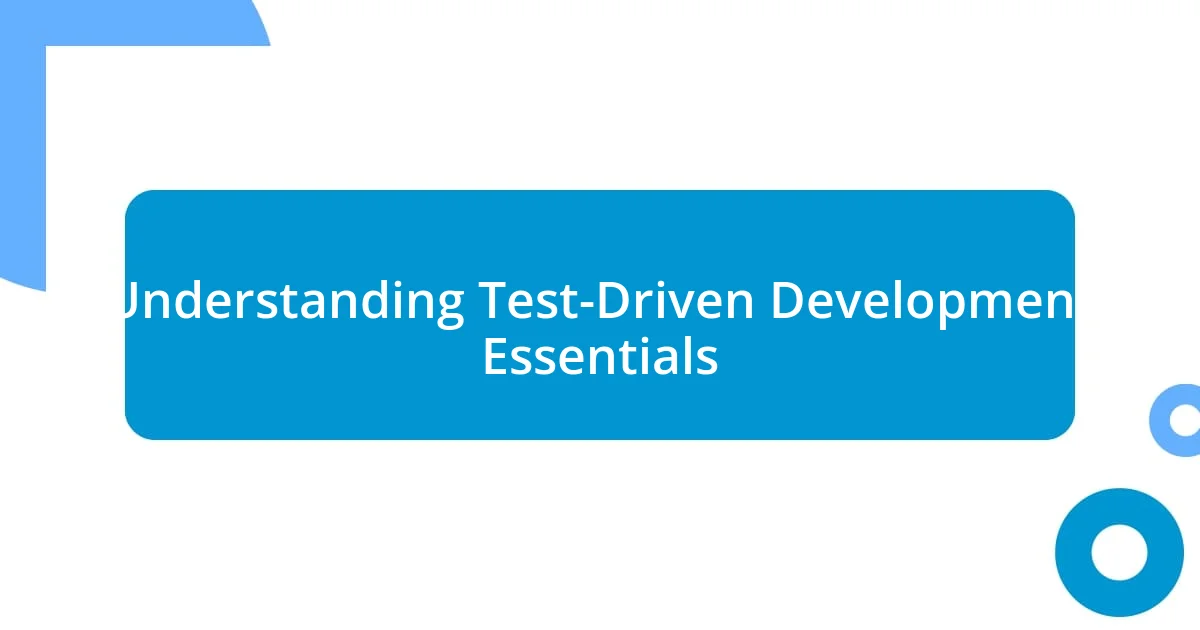
Understanding Test-Driven Development Essentials
Test-Driven Development (TDD) is an approach that flipped my perception of coding. At its core, TDD emphasizes writing tests before you even start coding, which was a bit of a mind-bending concept for me at first. Have you ever experienced the frustrating moment of debugging a feature, only to realize the scope was much larger than anticipated? TDD helps mitigate that chaos by allowing you to define what success looks like upfront.
Each cycle of TDD follows a simple mantra: Red, Green, Refactor. Initially, you write a failing test (Red), then make just enough code to pass that test (Green), and finally refine the code—improving its structure without altering its behavior (Refactor). I remember the first time I completed a refactor and realized how clean and efficient my code had become; it was a small victory that made all the difference in my confidence as a developer.
What surprised me the most about TDD was how it fostered deeper engagement with my code. Rather than writing tests as an afterthought, I learned to think critically about the functionality I wanted to create. Have you ever felt the thrill of seeing all your tests pass? It’s a unique satisfaction that not only solidifies your understanding but also builds reliability into your development process.
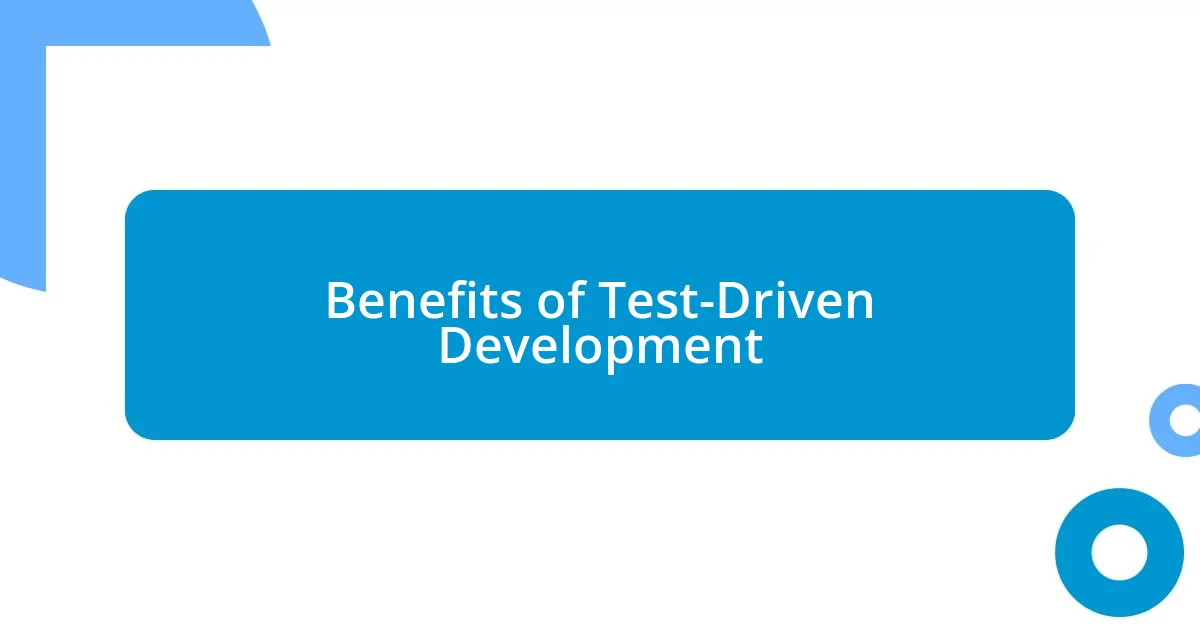
Benefits of Test-Driven Development
TDD offers the unbeatable advantage of confidence in code reliability. I still recall an instance where I was unsure of the overall functionality while working on a project. By adopting TDD, I laid out my tests beforehand, and that clarity not only guided my coding process but also greatly reduced my anxiety about possible bugs lurking in the shadows. This proactive approach ensures that you are on the right path from the very start.
One of the most delightful surprises of using TDD was how it accelerated my learning curve. Initially, I thought the process would slow me down, but I was astonished at how quickly I grasped new concepts. Each failing test pushed me to seek solutions and ultimately deepened my understanding of the codebase. Have you ever felt that rush when you finally resolve a tricky bug? That rewarding moment became a staple in my coding practice, reinforcing my knowledge over time.
When it comes to collaboration, TDD plays a pivotal role in aligning team efforts. I learned this firsthand during a project with several developers. With each test representing a clear goal, everyone was able to contribute more effectively. It created an environment where communication thrived and all team members were on the same page regarding project objectives and expectations. It’s like building a shared language around development that fosters unity.
| Benefit | Explanation |
|---|---|
| Enhanced Code Reliability | By writing tests first, TDD ensures that code meets defined requirements, reducing bugs. |
| Accelerated Learning | Developers deepen their understanding through the iterative nature of tests, promoting expertise. |
| Better Team Collaboration | TDD provides clarity and shared goals, enhancing communication and coordination among team members. |
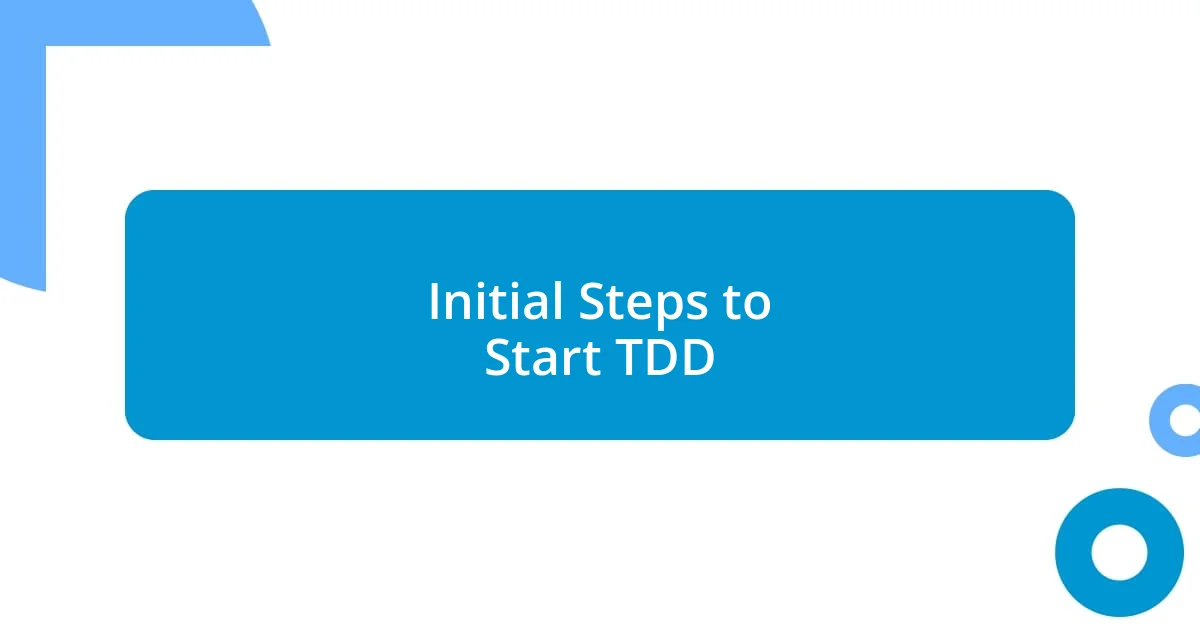
Initial Steps to Start TDD
Starting with Test-Driven Development (TDD) requires a thoughtful approach. I vividly recall the first step I took: I set aside a dedicated time to learn the principles of TDD. Embracing this practice meant understanding that it wasn’t just about coding; it was about adopting a new mindset. To ease into TDD, I recommend the following steps:
- Learn the basics: Familiarize yourself with the core concepts of TDD—Red, Green, Refactor.
- Choose a simple project: Start with something manageable to apply TDD without feeling overwhelmed.
- Select the right tools: Find testing frameworks compatible with your language and preferences.
As I began this journey, I also made it a point to write down my goals. I realized that clarity on what I wanted to achieve with each test motivated me to focus better. When I intentionally aimed for small, incremental victories, I found joy in the process. Writing my failing tests felt like planting seeds, knowing they would eventually blossom into functional features.
Engaging with TDD can be a rewarding experience. As I drafted my first tests, my anticipation grew. There was an electric thrill in watching the once-red tests turn green. Those moments reminded me that even small steps can lead to profound changes in my development approach. You will discover your own unique rhythm as you dive into TDD; enjoy each breakthrough along the way!
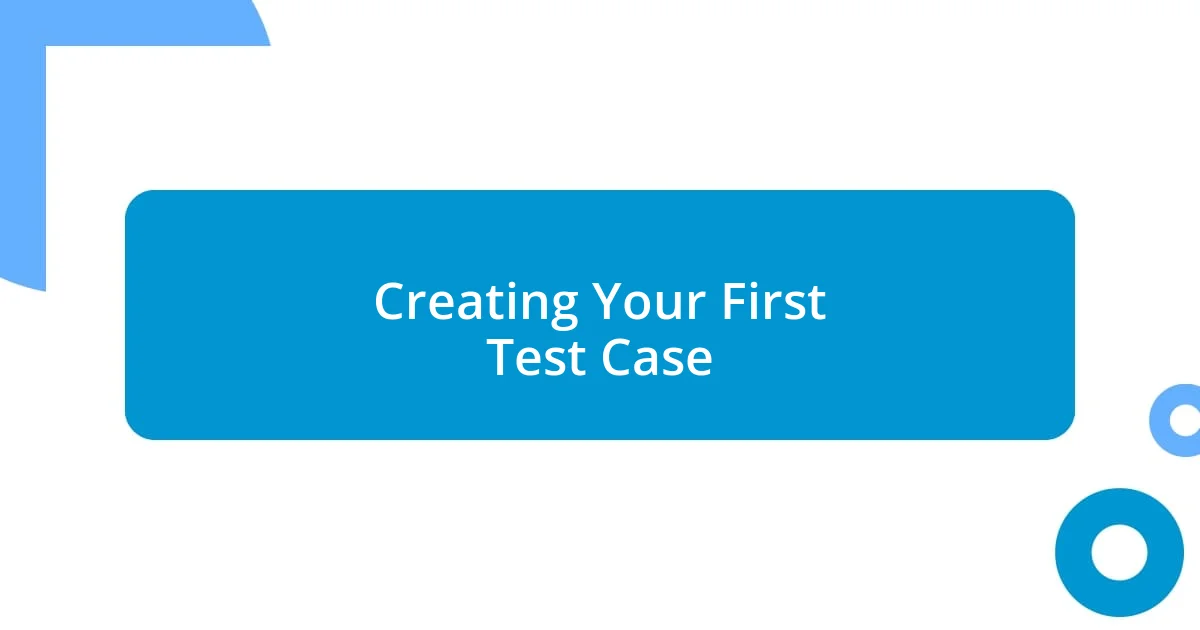
Creating Your First Test Case
Creating your first test case is like stepping into a new adventure. I remember the very first time I put pen to paper (or fingers to keyboard, more like it) to craft a test. It was for a simple function—a calculator that added numbers together. I felt a mix of excitement and trepidation. Would my test actually fail, or would I be greeted with success right away? That moment set the stage for what I would soon find to be a crucial lesson in my TDD journey.
I found that when writing my first test case, structuring it around a clear goal proved invaluable. For instance, instead of just checking if the function returned a number, I framed it as: What should happen when I add 2 and 3? This specificity not only gave me direction but also illuminated any assumptions I had about how the code should behave. Does this sound familiar? Ensuring that my expectations were clear made that first test case not just important, but empowering.
As I executed the test—and saw it fail—I experienced a moment of true clarity. It was a humbling reminder that failure is a part of growth. Trust me, it felt like a rite of passage! Each red mark on my screen churned with potential, urging me to understand why my code didn’t meet expectations. Have you ever felt that spark of determination? That’s where the learning happens, and it set the tone for every test I would write afterward.
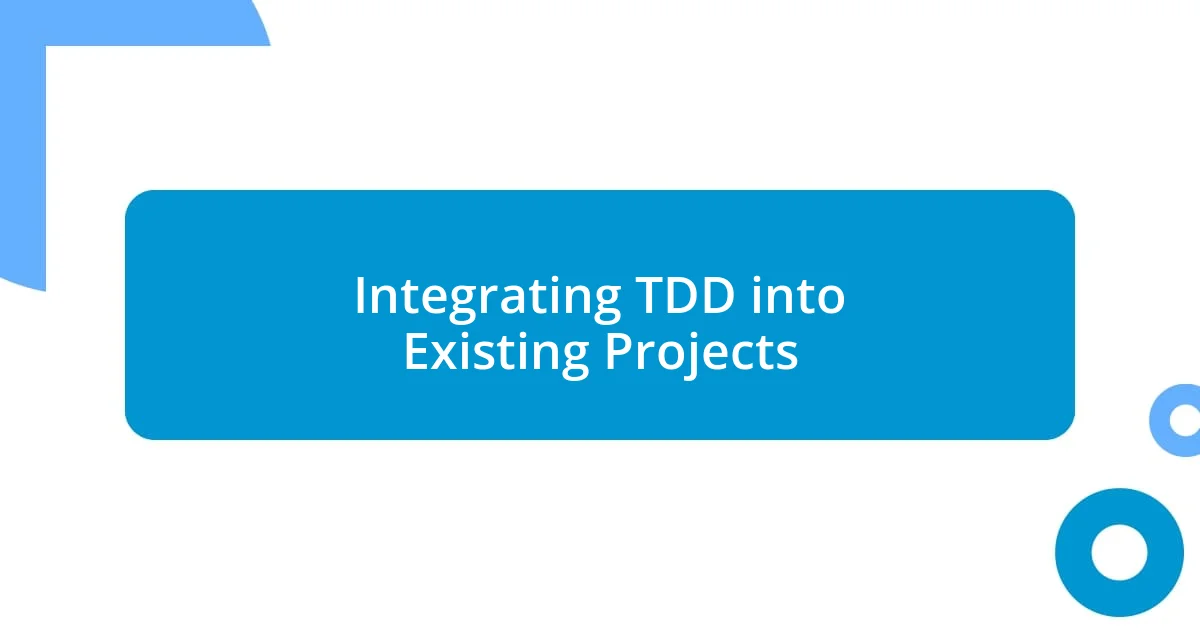
Integrating TDD into Existing Projects
Integrating TDD into existing projects can seem daunting, but I’ve found that taking small, calculated steps can lead to significant improvements. For example, when I first introduced TDD to a legacy codebase, I started by identifying key areas that needed refactoring or had a history of bugs. By focusing on these critical sections, I could begin adding tests gradually, which not only boosted confidence in the existing features but also eased the team into this new workflow.
As I worked through the integration, I remember the exhilarating feeling of transforming old, untested code into a testable framework. It’s essential to recognize that you don’t have to overhaul everything at once. Have you ever faced a mountain of legacy code? I often felt overwhelmed, yet every time I wrote a test for a previously untested function, I felt a sense of accomplishment that made the process worthwhile. This gradual approach helps your team embrace TDD without losing sight of the ongoing work.
Additionally, I discovered the importance of fostering a culture where tests are seen as valuable assets rather than obstacles. One strategy that worked well was sharing success stories with my colleagues. For instance, after integrating TDD into a feature that had long been prone to errors, I showcased how our new tests caught a critical bug before deployment. This not only cemented my belief in TDD but also sparked enthusiasm within the team. How can you cultivate a similar environment in your own projects? Sharing experiences can transform perspectives and pave the way for more efficient coding practices.
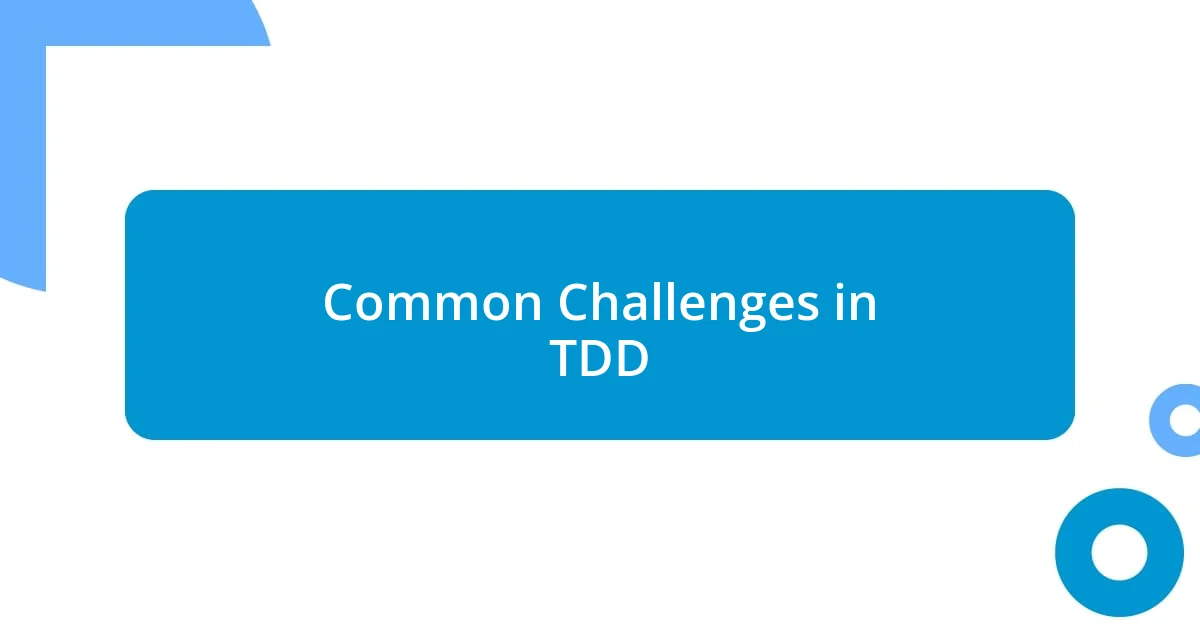
Common Challenges in TDD
Experiencing challenges in test-driven development (TDD) was something I didn’t anticipate. One notable hurdle was adjusting my mindset to view tests as living parts of the codebase rather than mere checkpoints. I remember working on a simple feature where, despite my tests passing, a subtle bug slipped through the cracks because I hadn’t accounted for edge cases. Have you ever overlooked those seemingly trivial details? That moment made me realize that thoroughness is essential.
Another common challenge I faced was maintaining momentum when the initial excitement faded. As I ventured deeper into TDD, there were days when writing tests felt tedious and repetitive. I’ll never forget the frustration of running into a stubborn piece of legacy code that refused to cooperate with my tests. It made me question if this whole approach was worth it. But those feelings were pivotal; they pushed me to refine my testing strategies and be more deliberate in my coding decisions.
Moreover, I discovered that collaboration can sometimes become a stumbling block. When working with a team, differing opinions on test practices often led to confusion and contention. I vividly recall a team meeting where we debated the right balance between unit and integration tests. It’s tough when opinions clash. How can you navigate these discussions effectively? I learned the importance of being open to feedback while also articulating the value of testing, fostering a more cohesive understanding of TDD among my peers.
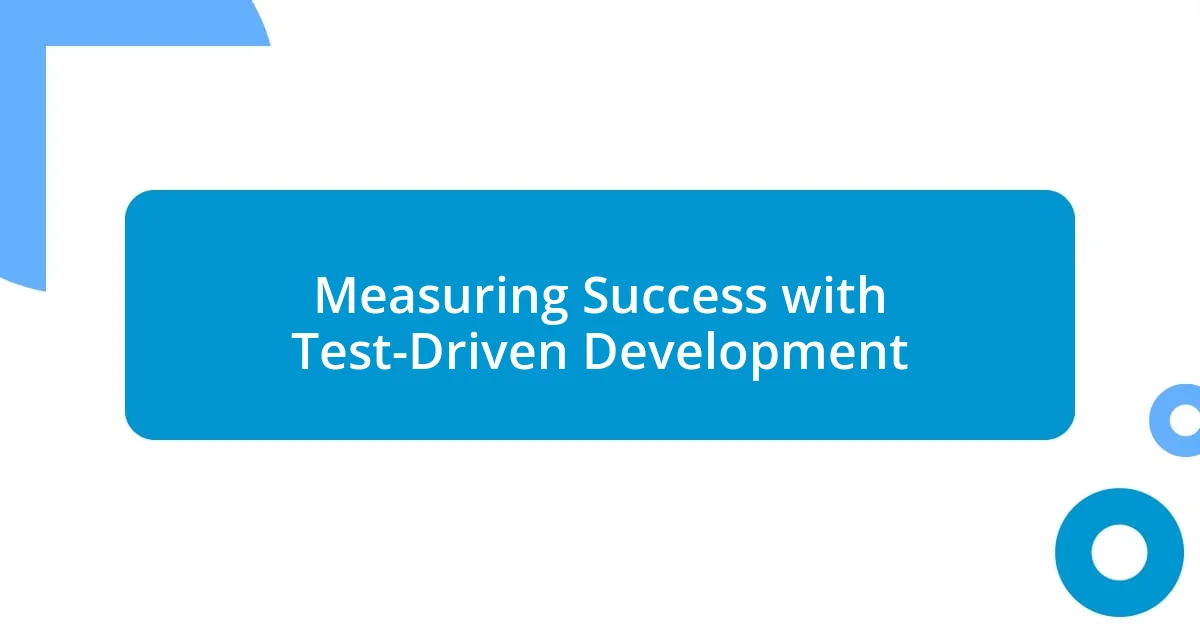
Measuring Success with Test-Driven Development
Success in test-driven development (TDD) goes beyond merely passing tests; it’s about building confidence in the codebase. I remember the thrill after shipping a major feature that had undergone rigorous testing. The feeling of knowing that we had a solid safety net beneath our code was liberating. But how do you gauge that success effectively? I started keeping track of metrics like the number of bugs reported post-deployment, which served as a clear indicator of how well TDD was working for us.
One unexpected success marker I encountered was the quality of team discussions during stand-ups. Initially, I would dread those meetings, often filled with vague updates and frustrations. But as we embraced TDD, conversations shifted to specific issues around test failures and the rationale behind certain design choices. It was invigorating to witness this transformation. Have you ever noticed how a common goal, like improving code quality, can unite a team? That shared understanding not only strengthened collaboration but also made our collective efforts feel rewarding.
In retrospect, one of the most significant measures of success has been the reduced time spent on debugging. I recall a sprint where we faced an unusual number of bugs, and our productivity slipped. Switching to TDD the following sprint resulted in fewer problems surfacing at the end of the cycle. Instead of being reactive, we became proactive, addressing potential pitfalls before any code was even deployed. Isn’t it satisfying when you finally make that shift from managing crises to preventing them in the first place? That change alone validated the effort we put into mastering TDD.












